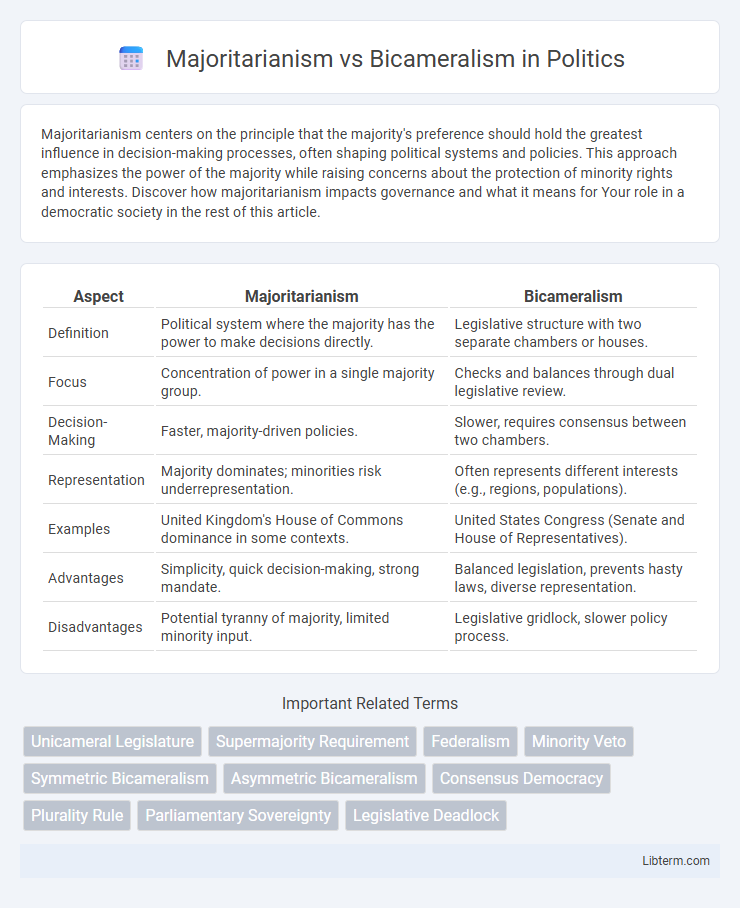Majoritarianism centers on the principle that the majority's preference should hold the greatest influence in decision-making processes, often shaping political systems and policies. This approach emphasizes the power of the majority while raising concerns about the protection of minority rights and interests. Discover how majoritarianism impacts governance and what it means for Your role in a democratic society in the rest of this article.
Table of Comparison
| Aspect | Majoritarianism | Bicameralism |
|---|---|---|
| Definition | Political system where the majority has the power to make decisions directly. | Legislative structure with two separate chambers or houses. |
| Focus | Concentration of power in a single majority group. | Checks and balances through dual legislative review. |
| Decision-Making | Faster, majority-driven policies. | Slower, requires consensus between two chambers. |
| Representation | Majority dominates; minorities risk underrepresentation. | Often represents different interests (e.g., regions, populations). |
| Examples | United Kingdom's House of Commons dominance in some contexts. | United States Congress (Senate and House of Representatives). |
| Advantages | Simplicity, quick decision-making, strong mandate. | Balanced legislation, prevents hasty laws, diverse representation. |
| Disadvantages | Potential tyranny of majority, limited minority input. | Legislative gridlock, slower policy process. |
Introduction to Majoritarianism and Bicameralism
Majoritarianism emphasizes decision-making by a majority, often leading to a single legislative chamber where the majority's preference dominates policy outcomes. Bicameralism features two separate chambers, typically designed to balance representation and provide checks on majority power through different methods of member selection or jurisdiction. These structures reflect contrasting approaches to legislative efficiency, representation, and the prevention of tyranny by the majority.
Defining Majoritarianism: Principles and Practices
Majoritarianism centers on the principle that the majority's preferences dictate policy decisions, emphasizing direct representation and electoral dominance. It operates through mechanisms such as simple majority voting, where the largest segment holds decisive power, ensuring governance reflects the will of the majority population. This practice often prioritizes majority interests, sometimes at the expense of minority rights, contrasting with bicameralism's structured legislative checks and balances.
Understanding Bicameralism: Structure and Rationale
Bicameralism refers to a legislative system composed of two separate chambers, typically an upper and lower house, designed to balance representation and prevent the concentration of power. This structure allows for more thorough debate and revision of laws, representing different interests such as regional entities or social groups, enhancing democratic accountability. The rationale behind bicameralism lies in ensuring checks and balances within the legislature, promoting stability and protecting minority rights against majoritarian dominance.
Historical Origins of Majoritarian and Bicameral Systems
Majoritarianism traces its origins to ancient Greek democracy, particularly in Athens, where decisions were made by the majority of citizens voting in assemblies. Bicameralism has roots in medieval England, evolving from the separation of the Parliament into the House of Commons and the House of Lords to balance the interests of commoners and the aristocracy. These distinct historical developments reflect majoritarianism's emphasis on direct citizen rule and bicameralism's focus on checks and balances within representative legislatures.
Key Differences Between Majoritarianism and Bicameralism
Majoritarianism centers on governance by the majority, where decisions reflect the preferences of the largest group, often emphasizing direct or parliamentary democracy. Bicameralism involves a legislative system with two chambers, typically designed to balance representation, such as a lower house representing population proportionally and an upper house representing regions or states. The key difference lies in majoritarianism's focus on majority rule in decision-making versus bicameralism's structural division of legislative power to provide checks and balances.
Advantages of Majoritarian Decision-Making
Majoritarian decision-making streamlines governance by enabling swift and clear policy implementation, reflecting the preferences of the majority electorate. This approach fosters political stability and accountability, as elected leaders must align with the decisive majority to maintain power. Majoritarianism enhances democratic legitimacy by ensuring that the dominant public opinion directly shapes legislative outcomes, reducing gridlock common in bicameral systems.
Benefits of Bicameral Legislative Systems
Bicameral legislative systems provide enhanced checks and balances by distributing power across two chambers, reducing the risk of majoritarian tyranny often seen in single-house majoritarian systems. This structure allows for more thorough scrutiny of legislation, encouraging diverse perspectives and preventing hasty decision-making. Countries like the United States and the United Kingdom demonstrate how bicameralism improves representation by balancing population-based and regional interests.
Criticisms and Challenges of Majoritarianism
Majoritarianism faces criticism for marginalizing minority groups and fostering a winner-takes-all political culture that undermines pluralism and social cohesion. It often leads to policy volatility and exclusionary governance by concentrating power in the hands of a simple majority, risking the tyranny of the majority. Challenges also include the difficulty of protecting minority rights and ensuring balanced representation, which bicameralism attempts to address through a two-chamber legislative system designed to provide checks and balances.
Critiques and Limitations of Bicameralism
Bicameralism often faces criticism for creating legislative gridlock due to the potential for conflicting interests between two chambers, which can delay or obstruct policy enactment. The unequal representation in many bicameral systems, where one house is often less directly accountable to the public, raises concerns about democratic legitimacy and responsiveness. Furthermore, bicameral structures frequently incur higher administrative costs and complexity, which can reduce governmental efficiency compared to majoritarian unicameral systems.
Majoritarianism vs Bicameralism: Impacts on Democracy and Governance
Majoritarianism concentrates power in the hands of the majority, often leading to swift decision-making but risking marginalization of minority groups and potentially undermining pluralistic democracy. Bicameralism introduces a dual-chamber system within the legislature, promoting checks and balances that enhance deliberation and prevent hasty policy shifts, thereby supporting more stable governance and protecting diverse interests. The tension between majoritarian dominance and bicameral moderation shapes democratic quality by balancing efficiency with inclusiveness and accountability in governance structures.
Majoritarianism Infographic

 libterm.com
libterm.com